9 Types of Blackbirds in Georgia (With Pictures)
Last Updated on
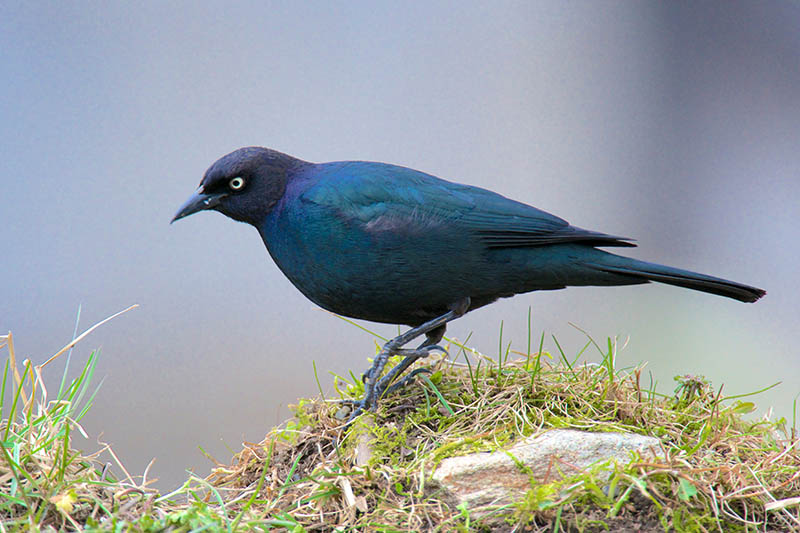
If you’re a bird lover, you may know that there is an abundance of blackbirds in Georgia. Blackbirds get a bad rap in most states because some are aggressive and tend to bully the smaller birds in the area.
However, not all blackbirds are bullies, which you’ll see in this article. Also, blackbirds are a bit far-reaching and cover a wide range. We’ll concentrate on the main types of blackbirds you can find in Georgia and a few facts about them you might want to know.

The 9 Types of Blackbirds in Georgia
1. Red-Winged Blackbird
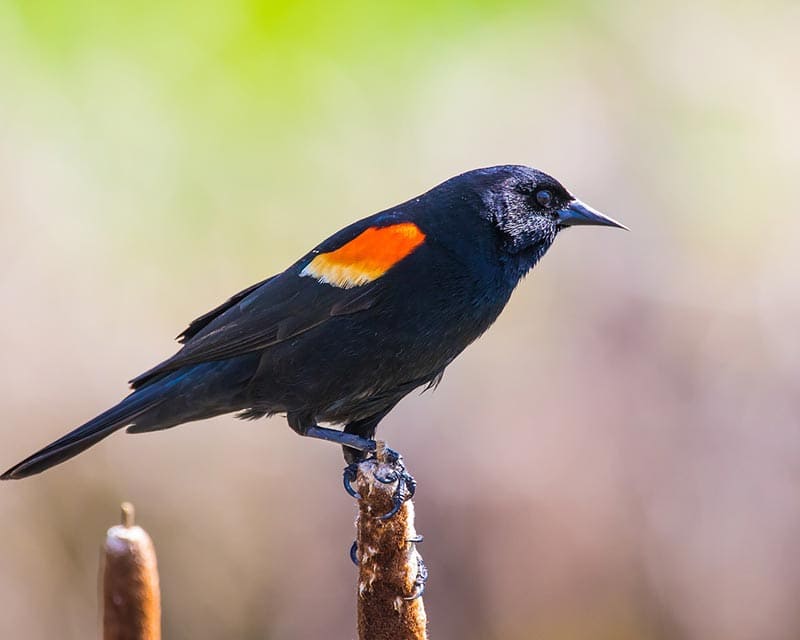
| 6.7 to 7.1 inches | Omnivore |
| 12.2-to-15.7-inch wingspan | Found in fresh and saltwater marshes |
| 1.1 to 2.7 ounces | Agelaius phoeniceus |
The Red-Winged Blackbird is the blackbird spotted most often in Georgia. The breed is easy for bird watchers to identify. The male of the species has an all-black coloring marred only by its reddish-orange wing patches. The female is dull in comparison to the male with their streaked brown colors.
The birds are often seen in fresh and saltwater marshes but will put nests in fields upon occasion. As omnivores, Red-Winged Blackbirds feast on insects during the summer and seeds in the winter months.
To attract them to your backyard, try spreading mixed grain and some seeds on the ground. They also eat from large tube and platform feeders as well.
2. European Starling
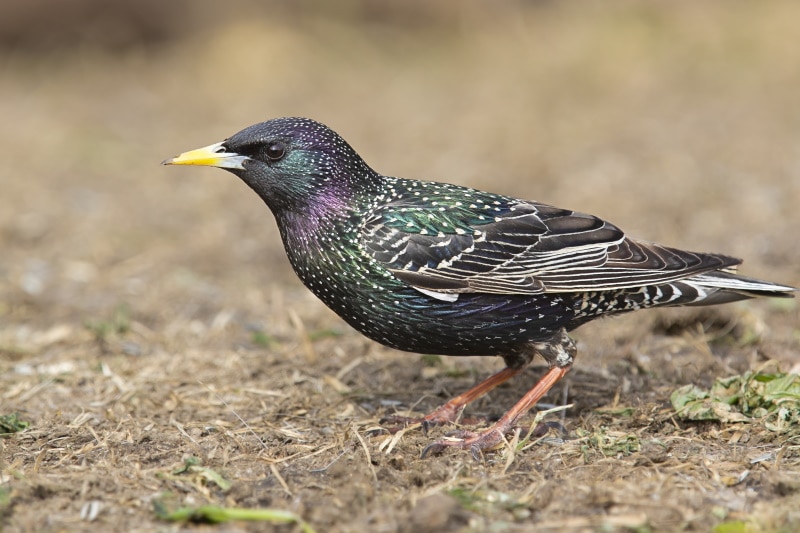
| 7.9 to 9.1 inches | Omnivore |
| 12.2-to-15.8-inch wingspan | Tops of trees |
| 2.1 to 3.4 ounces | Sturnus vulgaris |
The European Starling isn’t native to Georgia but is instead a species that was introduced to the state. You can see them on the tops of trees and other places all year round. While not native to the state, they are now counted among the most numerous songbirds in the area.
The bird is stocky and features black coloring with blue, purple, and green tones. The residents of Georgia consider the European Starling a pest because it’s aggressive to other birds and because they fly in large, noisy flocks.
You can find Starlings on the tops of trees and flying over fields. It is omnivorous, living on beetles, flies, spiders, earthworms, caterpillars, and other insects. They’ve also been known to eat fruit, such as blackberries, cherries, mulberries, holly berries, and various grains and seeds.
If you’re looking to attract European Starlings to your yard, though you might not want to, use peanuts, black oil, sunflower seeds, suet, and cracked corn for the best results.
3. Common Grackle
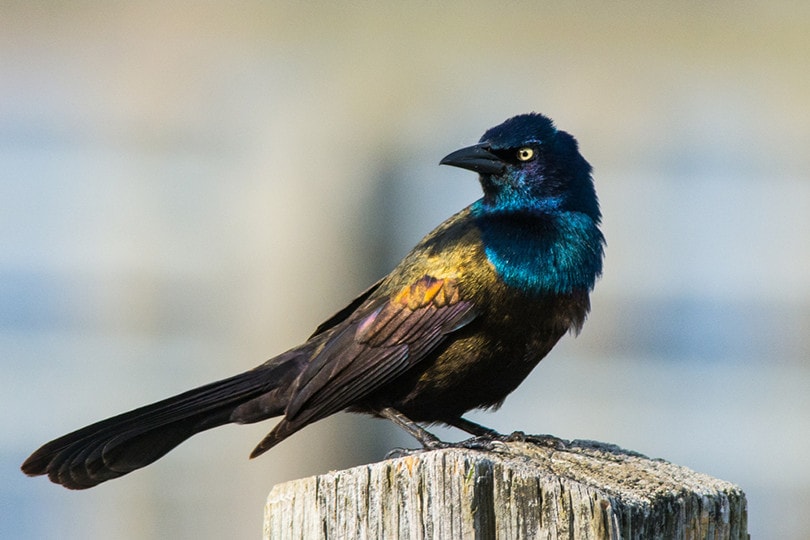
| 11.0 to 13.4 inches | Omnivore |
| 14.2-to-18.1-inch wingspan | Found in marshes, fields, parks, and open woodlands |
| 2.6 to 5.0 ounces | Quiscalus quiscula |
The Common Grackle is a near-threatened species but can still be seen in Georgia during the winter and summer. It is taller and longer than the typical blackbird and features a glossy iridescent body, with the females slightly less glossy than the males.
You can spot the Common Grackle in open woodlands, marshes, fields, and parks. They are omnivores that feast on mostly corn from crops but have been known to get into garbage cans and can be quite a nuisance. They gather high up in the trees and are known for being extremely noisy. If you want the birds in your backyard, sprinkle grain or seeds on the ground or put them in a platform feeder to draw them to your yard.
4. Rusty Blackbird
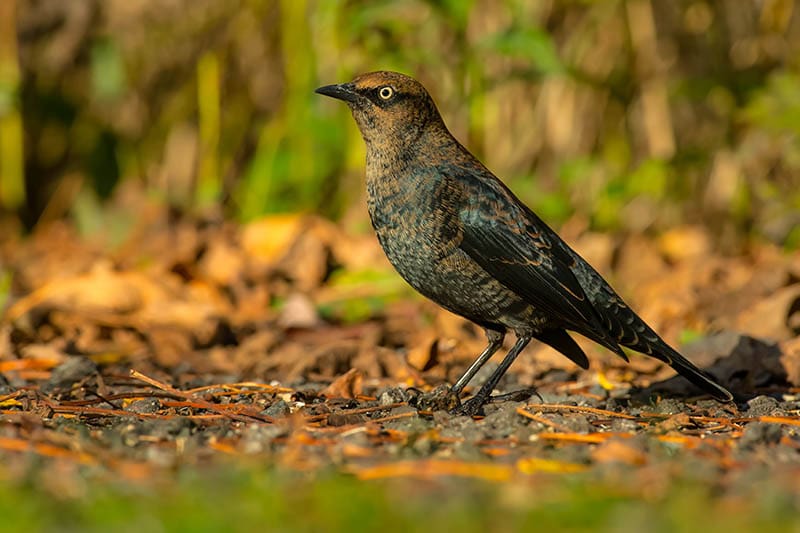
| 8.3 to 9.8 inches | Omnivore |
| 14.6-inch wingspan | Found in swamps, marshes, large ponds, and bogs |
| 1.7 to 2.8 ounces | Euphagus carolinus |
The Rusty Blackbird is a vulnerable species; if you’re lucky, you can still see them during the winter season in the peach state. They usually begin to arrive in Georgia in September and hang around until April. However, the best time to see one is from November to March.
It can be spotted in swamps, marshes, bogs, and large ponds. You’ll be able to identify them by their rusty appearance in winter. During the summer, they are a glossy black color instead.
Rusty Blackbirds are omnivorous, often feasting on small fish, insects, and seeds. They have been known to eat other birds as well, at times. There hasn’t been much that has been found to attract the species to backyards in Georgia. You have to hope you’ll be lucky enough to spot one when you’re out and about.
5. Brewer’s Blackbird

| 7.9 to 9.8 inches | Omnivore |
| 14.6-inch wingspan | Found near grasslands, swamps, marshes, and parks |
| 1.8 to 3.0 ounces | Euphagus cyanocephalus |
The Brewer’s Blackbird isn’t often seen in Georgia, but they are regularly in the state from October to April to get through the winter. It is a medium-sized bird with a glossy black coat. The males have purple on their heads and greenish colors on their bodies. The females, on the other hand, are just plain brown birds.
The blackbirds can be found in several locations throughout Georgia, including grasslands, marshes, swamps, and parks near humans.
If you want to attract them to your backyard, use cracked corn, hulled sunflower seeds, and millet.
6. Shiny Cowbird
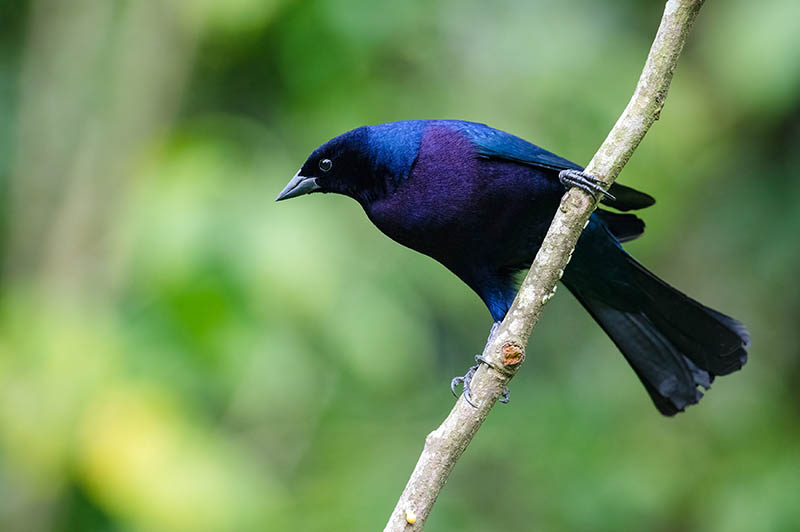
| 7.1 inches | Omnivore |
| 12-inch wingspan | Open areas |
| 1.1 to 1.4 ounces | Molothrus bonariensis |
The Shiny Cowbird was last spotted near Cucumber Island in 2018 and is an accidental species to the peach state. The male is a glossy dark purple, while the females are brown.
You can find the species in open areas eating seeds, grains, and insects from open feeders.
7. Scott’s Oriole

| 9.1 inch | Omnivore |
| 12.6-inch wingspan | Higher slopes |
| 1.1 to 1.4 ounces | Icterus parisorum |
The Scott’s Oriole is another accidental species found in Georgia. They are extremely rare in the Peach State but have been spotted. You can identify the Oriole by its black body and distinctive yellow belly.
It is omnivorous and can be found on high slopes eating insects, fruit, and nectar. If you’re lucky, you can see one of the birds by putting out jelly, oranges, or sugar water to attract them to your backyard.
8. Yellow-Headed Blackbird
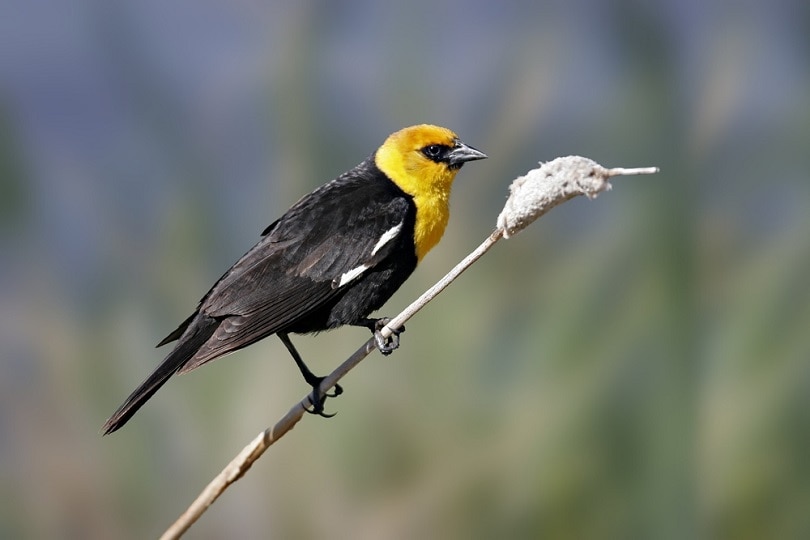
| 8.3 to 10.2 inches | Omnivore |
| 16.5-to-17.3-inch wingspan | Wetlands, grasslands, and fields |
| 1.6 to 3.5 ounces | Xanthocephalus xanthocehalus |
The Yellow-Headed Blackbird is very rarely seen in the peach state. However, they are said to be here, and sightings have picked up in the last few years. You can quickly identify the bird by its shiny yellow head and black body.
It is most often seen in the wetlands, grasslands, and fields. Yellow-Headed Blackbirds are omnivores, and they eat insects during the summer and seeds and grains during the winter months.
You can attract the rarely seen bird to your yard by sprinkling sunflower seeds on the ground.
9. Boat-Tailed Grackle

| 10-2 to 14.6 inches | Omnivore |
| 15.3-to-19.7-inch wingspan | Near saltwater |
| 3.3 to 8.4 ounces | Quiscalus major |
The Boat-Tailed Grackle can be observed in Georgia all year long. However, they are most often seen in the southern part of the state. The birds are large and have glossy black bodies and long legs. You will often find them near saltwater, where they dine on food that has been dropped or discarded by humans and eat crustaceans and seeds.
You can bring them to your backyard by using a platform feeder and filling it with millet, corn, and sunflower seeds.

How To Attract Birds to Your Backyard
You can easily attract birds to your backyard by providing food such as fresh fruit plants and berry bushes. You can also hang nectar feeders to attract Orioles and use feeders containing millet, peanuts, and cracked corn to attract other species.
Also, you should provide a freshwater source for the birds to drink from and bathe in. Ensure you don’t tidy the area near your feeders too much since the overgrown vegetation is the perfect spot for the birds to get insects.

Final Thoughts
The Peach State is a beautiful place to visit or to live, and you can easily attract blackbirds to your yard and more if you follow the tips above. If you’re a birdwatcher, you can find the Blackbirds on this list in their natural habitats wherever you go and attract them to your backyard as well.
Featured Image Credit: Danita Delimont, Shutterstock
About the Author Patricia Dickson
Patricia is an animal and coffee writer and a published author under the pen name Skylar McKinzie. When she isn’t writing, Patricia enjoys spending time with her two cats and dog. Since she was a young child, she has been a pet lover and enjoys nothing more than cuddling with her pets. Patricia loves sharing her knowledge of animals and finds joy in helping out at the local rescue shelter whenever she can.
Related Articles:
Monocular vs Telescope: Differences Explained (With Pictures)
10 Types of Hummingbirds in Arkansas (With Pictures)
8 Types of Hummingbirds in Nebraska (With Pictures)
5 Types of Hummingbirds in Idaho (With Pictures)
3 Types of Hummingbirds in Mississippi (With Pictures)
8 Types of Hummingbirds in Kansas (With Pictures)
5 Types of Hummingbirds in West Virginia (With Pictures)
5 Types of Hummingbirds in Ohio (With Pictures)
